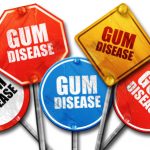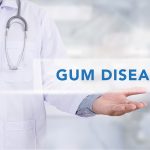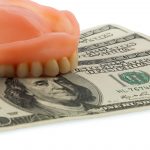Gum Disease: Signs, Symptoms & Treatments
Medically Reviewed by: W. Peter Nordland, DMD

On this page: Signs of gum disease | Common causes | Treatments | Cost of Treatment
Gum disease – also known as periodontal disease and periodontitis – is an inflammatory condition affecting the tissues surrounding a tooth and is the leading cause of tooth loss. Once it sets in, the toxins produced by the bacteria damage the teeth’s connective tissue and bone, effectively destroying them and fostering tooth loss.
Beware the Signs
Gingivitis is a bacterial infection of the tissues in the mouth and potential precursor of gum disease.
As a gum infection progresses, the bone tends to recede; the gums may or may not recede. In some cases, the root of the tooth becomes exposed, occasionally causing tooth sensitivity. Furthermore, pus may be produced, and pockets may form between the gum and tooth.
Since bone recession is not visible to the naked eye, and if left undetected, may contribute to tooth loss, it is important to visit your dentist for professional examinations and dental cleanings to identify gum disease.
Here are some common signs you and your dentist can look for:
- Bleeding gums during tooth brushing or otherwise
- Sensitive, red or swollen gums
- Bad breath
- teeth that are loose or appear to have shifted
Causes
Improper Dental Hygiene: If plaque is not removed through daily dental hygiene practices and regular professional dental cleanings, bacteria may set in and cause gingivitis, which may eventually result in gum disease.
Organic Changes in the Mouth: Changes that occur in metabolism and hormone levels during pregnancy, puberty and menopause may affect the organic balance in the mouth.
Medical Conditions: Serious conditions that affect the body’s ability to produce sugar (such as diabetes or kidney disease) may contribute to periodontal disease. Furthermore, the Center for Disease Control has found an association between certain illnesses (including diabetes, stroke and heart attack) and gum disease. Finally, medications used to treat medical conditions may produce the overgrowth of gums. Overgrown gums are more susceptible to bacteria, and therefore disease.
Saliva Flow Inhibitors: Certain medications that produce oral side effects or dry mouth syndrome (xerostomia) may contribute to a reduction of protective saliva flow, and potentially to gum disease. Seniors may be more susceptible to dry mouth syndrome because of the natural reduction of salivary flow associated with age.
Poor Functional Habits: Teeth grinding or clenching may impair the surrounding tissue and is a possible contributor to gingival issues.
Gum Disease Treatments
There are a number of treatments available for gum disease sufferers, each of which varies depending on the severity of the condition.
In order to determine the treatment modality that best meets your needs, your dentist will evaluate the extent of the damage to develop a conservative initial plan. A dental hygiene evaluation will determine if plaque (soft deposits on the tooth) is being removed on a daily basis.
Next, calculus (also known as tartar) must be removed through a professional cleaning, and sometimes through the additional procedures of deep scaling and root planing. A local anesthetic may be administered during these procedures. Your dentist may also administer antibiotics to treat bacteria housed in the pocketed areas of the gum and recommend a medicated mouthwash to be used as a regular part of your home regimen.
Advanced Treatments
Tissue Regeneration
- If the bone has been destroyed, your dentist may employ a new technique called tissue regeneration, which involves grafting the bone to offer a better chance of bone re-growth. To strengthen thin gums, soft tissue grafts may also be used.
- Guided tissue regeneration involves the insertion of a membrane to help in the bone regeneration process. This is sometimes useful during periodontal surgery.
Pocket Elimination Surgery
In some cases, surgery may be part of the treatment plan to help prevent tooth loss resulting from gum disease. Here are some surgical options:
- Periodontal flap surgery may be performed to reduce the pocket gap between the teeth and gums.
- If the jawbone has craters housing bacteria, the bone may be reshaped through bone surgery to eliminate the craters and help prevent future recolonization of bacteria growth.
Laser Therapy
- Laser therapy may be used to reduce pocket size; however, no definitive evidence exists to support the idea that laser therapy helps to restore damaged connective tissue damaged.
What Does Treatment Cost?
Gum disease treatment costs may be as little as $500, or as much as $10,000, depending on the severity of the disease.
The cost for a regular dental prophylaxis averages between $70 and $150, while the average cost for periodontal scaling and root planing is between $250 and $400. Periodontal maintenance costs after undergoing active therapy average $115. Active periodontal therapy — which usually consists of a locally administered antimicrobial agent delivered into the gum pockets — costs an average of $75 per tooth.
The cost depends on several factors. For example, additional routine tooth cleaning or scaling and root planing procedures at the gingivitis stage may be required in order to help prevent the onset of disease. This will further affect the cost of your treatment.
Other factors affecting costs include:
- The technology used in the procedure.
- The location of your dentist.
- The type of dental insurance you have.
- The type of treatment plan required.
Your dentist may perform the initial diagnosis and some treatment but may refer you to a periodontist with three additional years of gingival training who may be adept at performing more advanced treatment methods.
About the Reviewer
 W. Peter Nordland, DMD is Fellow of the American Academy of Esthetic Dentistry and an Active Member of the American Academy of Periodontology. He is a recognized leader in the field of esthetic oral plastic surgery and is currently in practice in La Jolla, CA, at the Nordland Oral Microsurgical Institute. Dr. Nordland has authored or co-authored four textbooks, and written chapters and several journal publications on periodontal plastic surgery. Over the past 20 years, Dr. Nordland has presented more than 200 professional papers. He lectures internationally for esteemed organizations such as the American Dental Association, the American College of Prosthodontists, the American Academy of Periodontology, the American Academy of Cosmetic Dentistry, the Academy of Osseointegration, the International Dental Federation, the American Academy of Esthetic Dentistry, and many of the state dental associations, including New York, Texas and California, in addition to most dental schools throughout the United States.
W. Peter Nordland, DMD is Fellow of the American Academy of Esthetic Dentistry and an Active Member of the American Academy of Periodontology. He is a recognized leader in the field of esthetic oral plastic surgery and is currently in practice in La Jolla, CA, at the Nordland Oral Microsurgical Institute. Dr. Nordland has authored or co-authored four textbooks, and written chapters and several journal publications on periodontal plastic surgery. Over the past 20 years, Dr. Nordland has presented more than 200 professional papers. He lectures internationally for esteemed organizations such as the American Dental Association, the American College of Prosthodontists, the American Academy of Periodontology, the American Academy of Cosmetic Dentistry, the Academy of Osseointegration, the International Dental Federation, the American Academy of Esthetic Dentistry, and many of the state dental associations, including New York, Texas and California, in addition to most dental schools throughout the United States.






